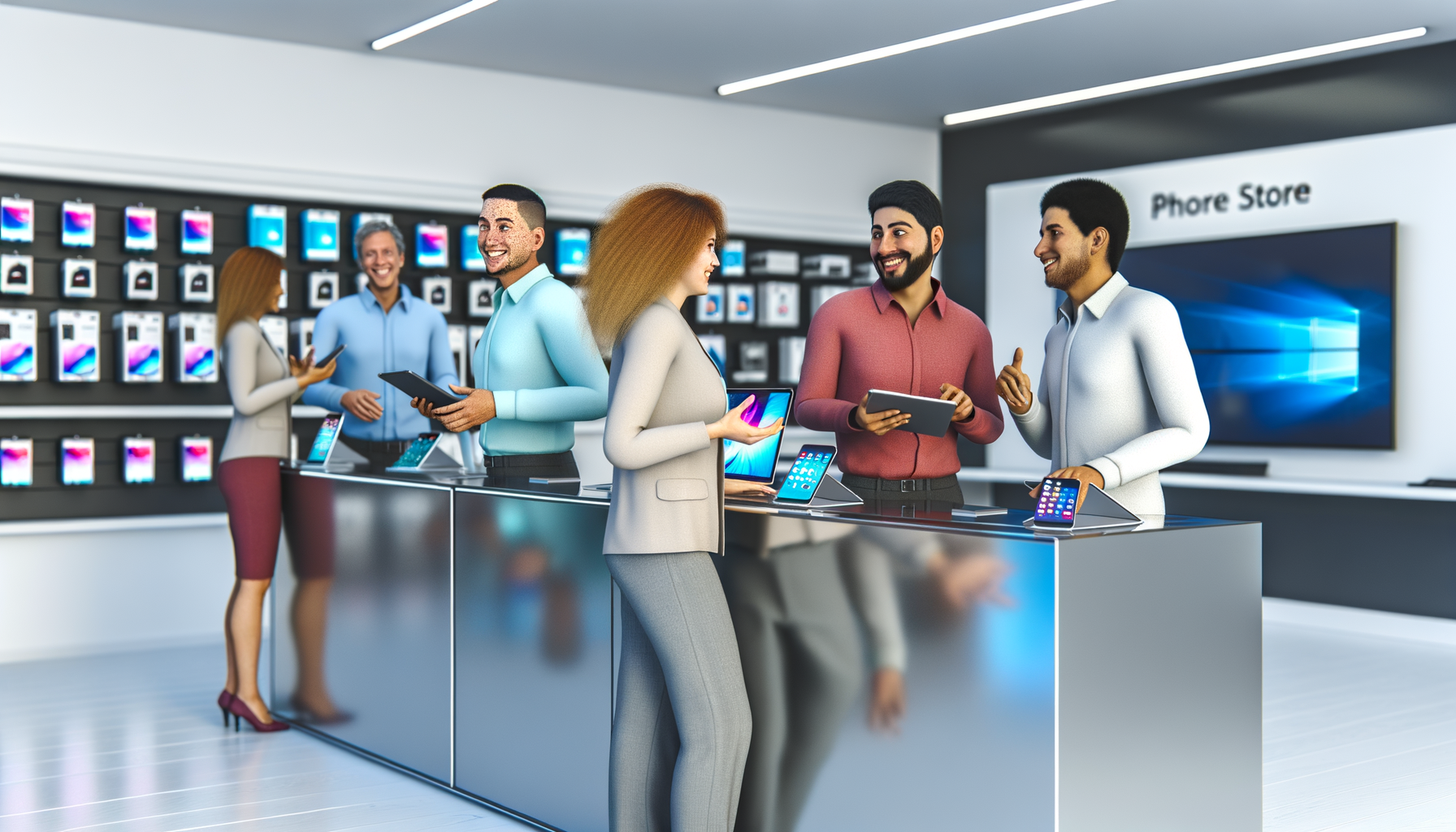
Introduction to Loyalty Programs in the Tech Industry
Definition and Importance
Loyalty programs are structured marketing strategies designed to encourage customers to continue to shop at or use the services of businesses associated with each program. In the tech industry, these programs are particularly crucial as they help companies retain customers in a highly competitive market. By offering rewards, discounts, or exclusive access to new products, tech companies can foster a sense of loyalty and community among their users. The importance of loyalty programs lies in their ability to enhance customer retention, increase lifetime value, and generate positive word-of-mouth, which is invaluable in an industry where customer acquisition costs are high.
Historical Context
The concept of loyalty programs dates back to the late 18th century when American retailers began offering copper tokens that could be redeemed for products on future purchases. However, the modern iteration of loyalty programs began in the 1980s with the introduction of frequent flyer programs by airlines. These programs were designed to reward repeat customers with points that could be redeemed for free flights, upgrades, and other perks. The tech industry adopted similar models in the late 1990s and early 2000s, with companies like Microsoft and Apple introducing their own loyalty schemes. Initially, these programs were simple, often involving point-based systems where customers earned points for purchases that could be redeemed for discounts or free products.
Current Trends
Today, loyalty programs in the tech industry have evolved significantly, driven by advancements in technology and changing consumer expectations. Here are some of the current trends:
- Personalization: Modern loyalty programs leverage data analytics and artificial intelligence to offer personalized rewards and experiences. By analyzing customer behavior and preferences, companies can tailor their loyalty programs to meet individual needs, making them more effective and engaging.
- Omnichannel Integration: Customers now expect a seamless experience across all touchpoints, whether online or offline. Tech companies are integrating their loyalty programs across multiple channels, including mobile apps, websites, and physical stores, to provide a consistent and convenient user experience.
- Emotional Engagement: Beyond transactional rewards, today’s loyalty programs focus on building emotional connections with customers. This involves offering experiential rewards, such as exclusive events, early access to new products, and personalized gifts, which help to create memorable experiences and foster deeper loyalty.
- Gamification: Incorporating game-like elements into loyalty programs is becoming increasingly popular. By introducing challenges, competitions, and achievements, companies can make their loyalty programs more engaging and fun, encouraging greater participation and long-term commitment.
- Sustainability and Social Responsibility: Many tech companies are aligning their loyalty programs with social and environmental causes. By allowing customers to earn rewards for sustainable actions or donate their points to charitable organizations, companies can enhance their brand image and appeal to socially conscious consumers.
In summary, loyalty programs in the tech industry have come a long way from their humble beginnings. They have transformed into sophisticated, data-driven engagement tools that not only reward transactions but also build emotional connections and provide personalized experiences. As technology continues to advance, these programs will likely become even more integral to customer retention and brand loyalty strategies.
Types of Innovative Loyalty Programs
Point-Based Systems
Point-based systems are one of the most traditional yet effective types of loyalty programs. In these systems, customers earn points for every purchase they make, which can later be redeemed for rewards such as discounts, free products, or exclusive services. The simplicity and transparency of point-based systems make them highly popular among consumers.
- Ease of Use: Customers understand the straightforward mechanism of earning and redeeming points, making it easy for them to engage with the program.
- Flexibility: Businesses can tailor the points system to fit their specific needs, offering different point values for various products or services.
- Data Collection: These programs provide valuable data on customer purchasing behavior, which can be used to personalize future offers and improve customer experience.
Tiered Programs
Tiered loyalty programs add an element of gamification by offering different levels of rewards based on the customer’s spending or engagement. The more a customer spends or engages, the higher they climb in the tier system, unlocking more valuable rewards.
- Increased Engagement: The competitive nature of tiered programs encourages customers to spend more to reach higher tiers.
- Exclusive Rewards: Higher tiers can offer exclusive benefits such as early access to new products, special discounts, or personalized services.
- Customer Retention: The desire to maintain or improve their tier status keeps customers coming back.
Subscription-Based Models
Subscription-based loyalty programs require customers to pay a recurring fee to access exclusive benefits. These programs are particularly effective for businesses that offer ongoing services or products, such as streaming services, fitness centers, or retail memberships.
- Guaranteed Revenue: The recurring fees provide a steady stream of income for the business.
- Enhanced Value: Customers perceive higher value in the exclusive benefits they receive, such as free shipping, special discounts, or premium content.
- Customer Commitment: The upfront investment encourages customers to make the most of their subscription, increasing their engagement and loyalty.
Gamification
Gamification involves incorporating game-like elements into the loyalty program to make it more engaging and fun for customers. This can include earning badges, completing challenges, or participating in competitions.
- Increased Engagement: The interactive and competitive nature of gamification keeps customers engaged and motivated to participate.
- Social Sharing: Gamified elements often encourage customers to share their achievements on social media, increasing brand visibility and attracting new customers.
- Emotional Connection: By making the loyalty program enjoyable, businesses can create a stronger emotional connection with their customers, fostering long-term loyalty.
In conclusion, innovative loyalty programs such as point-based systems, tiered programs, subscription-based models, and gamification are transforming the way businesses engage with their customers. By leveraging these strategies, companies can not only increase customer retention but also build deeper, more meaningful relationships with their clientele.
Technological Advancements Enhancing Loyalty Programs
Artificial Intelligence and Machine Learning
Artificial Intelligence (AI) and Machine Learning (ML) are revolutionizing loyalty programs by enabling unprecedented levels of personalization and efficiency. These technologies analyze vast amounts of customer data to identify patterns and predict future behaviors. This allows businesses to tailor rewards and communications to individual preferences, making loyalty programs more relevant and engaging. For instance, AI can help segment customers into different groups based on their purchasing habits, enabling more targeted marketing efforts. Machine learning algorithms can also optimize the timing and type of rewards offered, ensuring they resonate with each customer.
Blockchain Technology
Blockchain technology is emerging as a game-changer for loyalty programs, offering enhanced security, transparency, and efficiency. By using blockchain, companies can create decentralized loyalty platforms where points and rewards are securely stored and easily transferable. This eliminates the risk of fraud and ensures that customers can trust the integrity of the program. Additionally, blockchain can facilitate the interoperability of loyalty points across different programs and brands, providing customers with more flexibility and value. For example, a customer could use points earned from one retailer to redeem rewards at another, enhancing the overall appeal of the loyalty program.
Mobile Apps and Digital Wallets
The integration of mobile apps and digital wallets into loyalty programs has significantly improved customer convenience and engagement. Mobile apps allow customers to easily track their points, receive personalized offers, and redeem rewards directly from their smartphones. Digital wallets further streamline the process by enabling seamless transactions and reward redemptions without the need for physical cards. This integration not only enhances the user experience but also provides businesses with valuable data on customer behavior, which can be used to further refine and personalize the loyalty program. For instance, Starbucks’ mobile app allows customers to order ahead, pay, and earn rewards all in one place, driving higher engagement and satisfaction.
Data Analytics
Data analytics is at the core of modern loyalty programs, providing the insights needed to understand and predict customer behavior. By analyzing data from various touchpoints, businesses can gain a comprehensive view of their customers’ preferences and habits. This information can be used to create more effective and personalized loyalty strategies. For example, data analytics can help identify which rewards are most appealing to different customer segments, allowing businesses to tailor their offerings accordingly. Additionally, real-time analytics can track the performance of loyalty campaigns, enabling quick adjustments to maximize their effectiveness. This data-driven approach ensures that loyalty programs remain relevant and engaging, ultimately driving higher customer retention and satisfaction.
Strategies for Implementing Effective Loyalty Programs
Understanding Customer Needs
To implement an effective loyalty program, it is crucial to start with a deep understanding of your customers’ needs and preferences. This involves gathering and analyzing data on customer behavior, purchase history, and feedback. By leveraging data analytics, businesses can segment their customer base and tailor their loyalty programs to meet the specific needs of different customer groups. For instance, frequent buyers might appreciate exclusive discounts, while occasional shoppers might be more motivated by special promotions or limited-time offers. Understanding these nuances allows businesses to design loyalty programs that are more relevant and engaging.
Personalization and Customization
Personalization is a key driver of customer engagement in loyalty programs. By using advanced technologies such as artificial intelligence and machine learning, businesses can create highly personalized experiences for their customers. This can include personalized offers, recommendations, and communications that resonate with individual preferences and behaviors. Customization options in loyalty program software allow businesses to tailor rewards and incentives to align with their brand and customer expectations. For example, a tech company might offer early access to new products or exclusive tech support as part of their loyalty program. Personalization not only enhances the customer experience but also fosters a deeper emotional connection with the brand.
Transparency and Communication
Transparency and clear communication are essential for building trust and loyalty among customers. Customers should have a clear understanding of how the loyalty program works, including how to earn and redeem rewards, the value of the rewards, and any terms and conditions. Regular communication through various channels such as email, mobile apps, and social media keeps customers informed and engaged. It is also important to provide a seamless and user-friendly experience, ensuring that customers can easily access their loyalty program information and track their rewards. Transparent and consistent communication helps to build credibility and encourages ongoing participation in the loyalty program.
Incentives and Rewards
The success of a loyalty program largely depends on the incentives and rewards offered. These should be attractive and valuable enough to motivate customers to participate and stay engaged. Businesses can offer a variety of rewards such as points-based systems, discounts, exclusive access to products or events, and personalized gifts. It is also beneficial to incorporate gamification elements, such as challenges and competitions, to make the loyalty program more engaging and fun. Additionally, offering tiered rewards can incentivize customers to increase their spending or engagement to reach higher levels of benefits. By providing meaningful and appealing rewards, businesses can drive customer loyalty and increase retention rates.
In conclusion, implementing an effective loyalty program requires a strategic approach that focuses on understanding customer needs, personalizing the experience, maintaining transparency, and offering valuable incentives. By leveraging advanced technologies and data analytics, businesses can create loyalty programs that not only reward transactions but also build lasting emotional connections with their customers.
Case Studies of Successful Loyalty Programs
Small Business Examples
Small businesses often face unique challenges in implementing loyalty programs due to limited resources. However, many have found innovative ways to engage their customers effectively.
Example: Local Coffee Shop
A local coffee shop implemented a digital punch card system through a mobile app. Customers earn a digital stamp for each purchase, and after ten stamps, they receive a free beverage. This simple yet effective program has increased repeat visits and customer satisfaction. The app also allows the coffee shop to send personalized offers and updates, further enhancing customer engagement.
Example: Boutique Retail Store
A boutique retail store introduced a tiered loyalty program where customers earn points for every dollar spent. These points can be redeemed for discounts on future purchases. The store also offers exclusive early access to new collections and special events for top-tier members. This approach has not only boosted sales but also created a sense of exclusivity and community among loyal customers.
Large Enterprise Examples
Large enterprises have the advantage of extensive resources and customer data, allowing them to create highly sophisticated loyalty programs.
Example: Starbucks Rewards
Starbucks Rewards is a prime example of a successful loyalty program in a large enterprise. Members earn “stars” for every purchase, which can be redeemed for free drinks and food. The program is integrated with the Starbucks mobile app, making it easy for customers to track their rewards and receive personalized offers. The app also provides convenience features like mobile ordering and payment, enhancing the overall customer experience.
Example: Amazon Prime
Amazon Prime is another exemplary loyalty program. For an annual fee, members receive benefits such as free two-day shipping, access to streaming services, and exclusive deals. The comprehensive nature of the program ensures that members find value in multiple aspects of their daily lives, leading to high retention rates and increased customer loyalty.
Educational Institutions
Educational institutions are also leveraging loyalty programs to engage students, alumni, and staff.
Example: University Alumni Programs
Many universities have developed alumni loyalty programs that offer benefits such as discounts on continuing education courses, access to exclusive events, and networking opportunities. These programs help maintain a strong connection between the institution and its alumni, fostering a sense of community and ongoing engagement.
Example: Student Reward Programs
Some universities have implemented reward programs for students that offer points for participating in campus activities, attending events, and achieving academic milestones. These points can be redeemed for various rewards, such as bookstore discounts or priority registration for classes. Such programs encourage active participation in campus life and academic excellence.
Government Agencies
Government agencies are increasingly adopting loyalty programs to enhance public engagement and service utilization.
Example: Public Transportation Systems
Several cities have introduced loyalty programs for public transportation users. For instance, commuters earn points for each trip taken using public transit, which can be redeemed for discounts on future rides or other city services. These programs encourage the use of public transportation, reducing traffic congestion and promoting environmental sustainability.
Example: Health and Wellness Programs
Government health agencies have launched wellness programs that reward citizens for healthy behaviors, such as regular exercise, attending health screenings, and participating in wellness workshops. Participants earn points that can be exchanged for health-related products and services. These programs aim to improve public health outcomes and reduce healthcare costs by encouraging preventive care and healthy lifestyles.
These case studies illustrate the diverse ways in which loyalty programs can be tailored to different sectors and organizational sizes. By understanding and addressing the specific needs and behaviors of their target audiences, these programs have successfully enhanced customer engagement and loyalty.
Challenges and Solutions in Loyalty Program Implementation
Data Privacy and Security
In the digital age, data privacy and security are paramount concerns for both businesses and consumers. Loyalty programs often require the collection of personal information, which can make them targets for cyberattacks. Ensuring robust data protection measures is essential to maintain customer trust and comply with regulations such as GDPR and CCPA.
Challenges:
- Ensuring compliance with data protection regulations.
- Protecting against data breaches and cyberattacks.
- Maintaining customer trust in data handling practices.
Solutions:
- Implement Advanced Security Measures: Use encryption, secure servers, and regular security audits to protect customer data.
- Compliance Training: Regularly train staff on data protection laws and best practices.
- Transparency: Clearly communicate data usage policies to customers and provide options for data control.
Customer Engagement
Keeping customers engaged in a loyalty program is a continuous challenge. Traditional methods can become monotonous, leading to decreased participation and program abandonment.
Challenges:
- Maintaining long-term customer interest and participation.
- Creating meaningful and personalized rewards.
- Ensuring the program remains relevant and exciting.
Solutions:
- Personalization: Use data analytics to tailor rewards and communications to individual customer preferences.
- Gamification: Incorporate game-like elements such as points, badges, and challenges to make the program more engaging.
- Regular Updates: Continuously refresh the program with new rewards, tiers, and experiences to keep it exciting.
Cost Management
Implementing and maintaining a loyalty program can be costly. Balancing the expenses with the benefits is crucial for the program’s sustainability.
Challenges:
- High initial setup and ongoing operational costs.
- Ensuring a positive return on investment (ROI).
- Managing the cost of rewards and incentives.
Solutions:
- Budget Planning: Develop a detailed financial model to forecast costs and revenues.
- Partnerships: Collaborate with other businesses to share costs and offer joint rewards.
- Efficiency: Use technology to automate processes and reduce operational costs.
Technological Barriers
The integration of advanced technologies such as AI, blockchain, and mobile apps can enhance loyalty programs but also presents significant challenges.
Challenges:
- Integrating new technologies with existing systems.
- Ensuring user-friendly interfaces and experiences.
- Keeping up with rapid technological advancements.
Solutions:
- Scalable Solutions: Choose technologies that can grow with your business and adapt to future needs.
- User-Centric Design: Focus on creating intuitive and seamless user experiences.
- Continuous Learning: Stay updated with the latest technological trends and innovations to keep your program cutting-edge.
Future of Loyalty Programs in the Tech Industry
Emerging Technologies
The future of loyalty programs in the tech industry is being shaped by a range of emerging technologies. Artificial Intelligence (AI) and Machine Learning (ML) are at the forefront, enabling businesses to analyze vast amounts of customer data to predict behaviors and personalize rewards. These technologies help create more engaging and relevant loyalty experiences by tailoring offers to individual preferences.
Blockchain technology is another game-changer, providing enhanced security and transparency. Blockchain can ensure that loyalty points are accurately tracked and redeemed, reducing fraud and increasing trust among customers. Additionally, mobile apps and digital wallets are making it easier for customers to manage their loyalty points and rewards seamlessly, integrating these programs into their daily lives.
Evolving Customer Expectations
Today’s consumers expect more than just transactional rewards; they seek emotional connections with brands. Loyalty programs are evolving to meet these expectations by offering personalized experiences that resonate with individual preferences. Customers now expect omnichannel experiences, where they can interact with loyalty programs across various touchpoints, whether online, in-store, or through mobile apps.
Moreover, there is a growing demand for real-time rewards and instant gratification. Customers want to see immediate benefits from their loyalty, which is driving the adoption of technologies that can deliver instant rewards and personalized offers based on real-time data.
Sustainability and Ethical Considerations
As consumers become more conscious of environmental and ethical issues, loyalty programs are also evolving to reflect these values. Brands are increasingly incorporating sustainable practices into their loyalty programs, such as offering rewards for eco-friendly behaviors or partnering with ethical brands.
Ethical considerations are also becoming more prominent, with customers expecting transparency in how their data is used. Brands that prioritize data privacy and ethical use of customer information are likely to build stronger, more trusting relationships with their customers.
Global Trends
The globalization of the tech industry is influencing the future of loyalty programs. Cross-border loyalty programs are becoming more common, allowing customers to earn and redeem points internationally. This trend is particularly relevant for global brands and e-commerce platforms that serve a diverse, international customer base.
Additionally, there is a growing emphasis on cultural customization. Brands are tailoring their loyalty programs to meet the unique preferences and behaviors of customers in different regions. This approach not only enhances customer engagement but also helps brands build a more inclusive and diverse customer base.
In conclusion, the future of loyalty programs in the tech industry is being shaped by emerging technologies, evolving customer expectations, sustainability and ethical considerations, and global trends. By leveraging these factors, brands can create more engaging, personalized, and ethical loyalty programs that resonate with today’s tech-savvy consumers.




